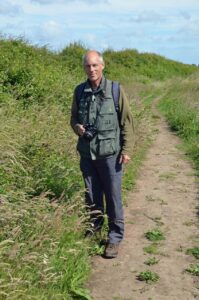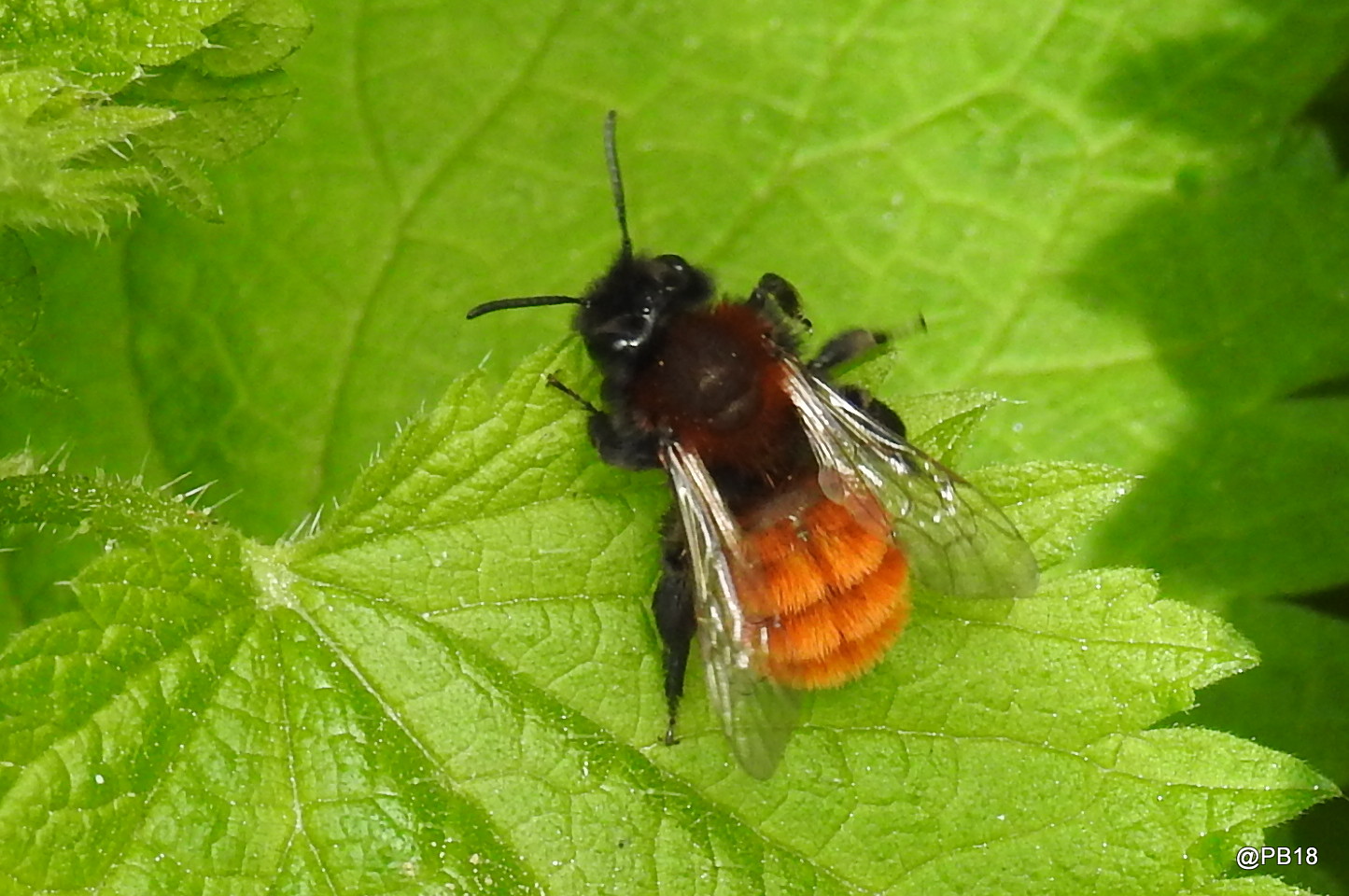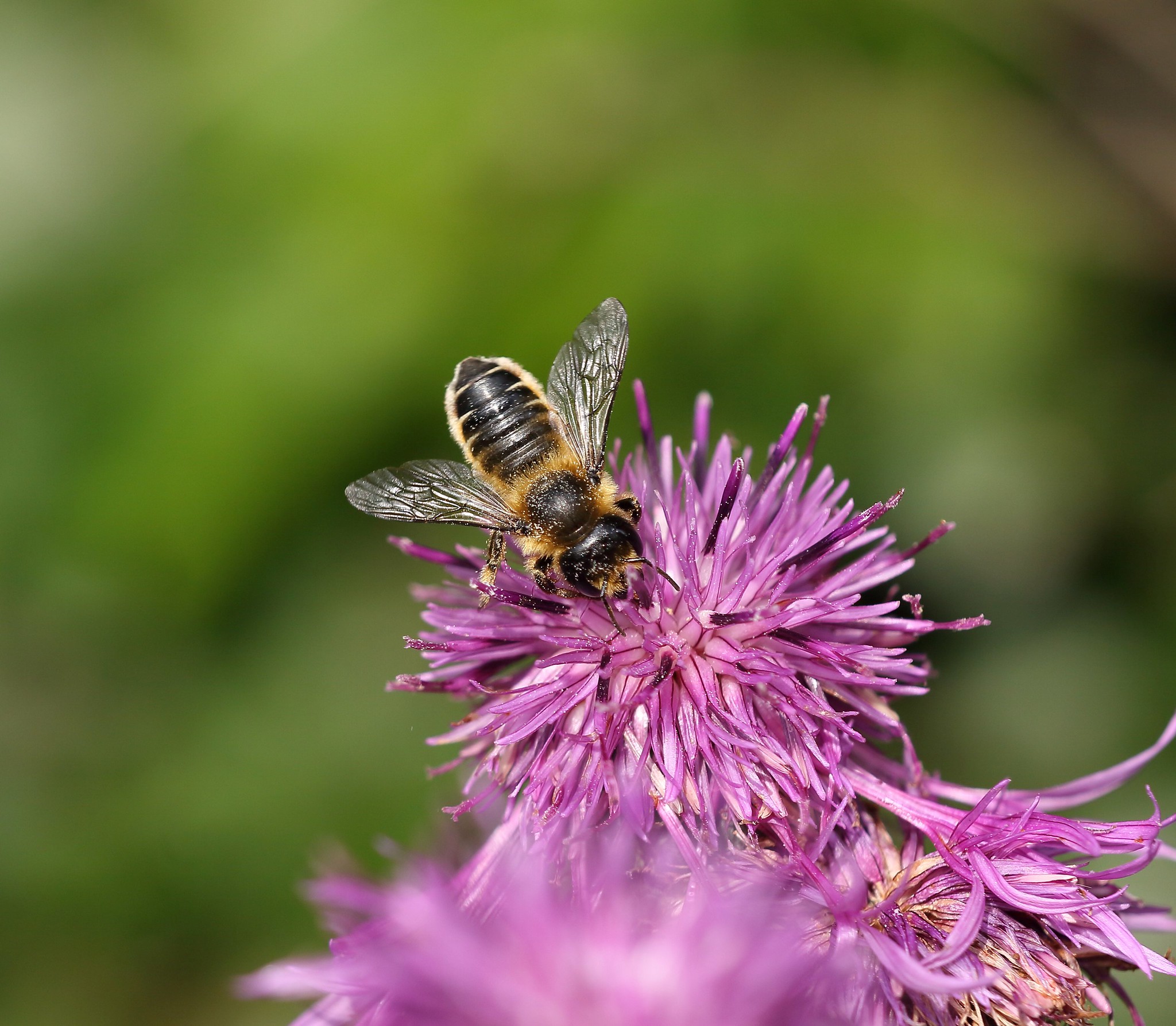 Solitary Bees is the newest volume in the New Naturalist series, drawing on the great wave of new knowledge to give a wonderful insight into the complicated lives of solitary bees. Honey bees and bumblebees make up only a small proportion of the bee species that live in Britain but are often the ones people first think about when discussing bees. Now, it is recognised that the other bees, whose 230 or so species make up the majority, play an important role in the pollination of crops and wild flowering plants.
Solitary Bees is the newest volume in the New Naturalist series, drawing on the great wave of new knowledge to give a wonderful insight into the complicated lives of solitary bees. Honey bees and bumblebees make up only a small proportion of the bee species that live in Britain but are often the ones people first think about when discussing bees. Now, it is recognised that the other bees, whose 230 or so species make up the majority, play an important role in the pollination of crops and wild flowering plants.

Authors Ted Benton and Nick Owens are entomologists that have a particular interest in behaviour and ecology. Both have written several previous books on bees, including Bumblebees, The Bees of Norfolk and The Bumblebee Book. The main focus of this new book is on the wonderful complexity of the behaviour and ecology of solitary bees, a remarkable group of insects.
Could you tell us how you both became interested in entomology and what drew you to write this new book?
(TB) Since my earliest memories, I have been fascinated by insects – finding Large White chrysalids on a playground wall, or, later, seeing such species as the Silver-spotted Skipper in a museum showcase, and wondering if I would ever get to see one. That led to an attempt (over more than 35 years) to photograph all the European butterfly species in their natural habitats. Meanwhile, I became interested in other, less spectacular groups of insects, and wrote about dragonflies, grasshoppers and crickets and bumblebees. To manage these interests alongside family life and work commitments, I chose groups with relatively few species, in the hope that would be easier. Since then – partly through the expert help from leading lights in the Bees, Wasps and Ants Recording Society (BWARS) – I was led to appreciate the great diversity and awesome fascination of this larger group of insects. Then I met up with Nick, and he seemed to be an ideal companion with whom to work on the project. An impression that was amply confirmed as we worked together over five years or more.

(NWO) I have been interested in all aspects of natural history from an early age, growing up in Yorkshire beside the River Foss. I was intrigued by aquatic insects and was also very excited to rear moths such as the Garden Tiger from caterpillars. Later my interests revolved especially around birds and I was employed by the Nature Conservancy to study Brent Geese. A diversion from birds included a PhD study of baboons in East Africa. After a teaching career, an intense interest in wild bees developed in retirement and led to the publication of The Bees of Norfolk. Ted and my shared interest in solitary bees resulted in the joint New Naturalist project, which was originally offered to Ted, following his two previous excellent publications in the series and his monograph on Solitary Bees (Naturalists’ Handbooks).
This book celebrates the solitary bee, a type of bee that’s often overlooked in favour of honey bees and bumblebees, despite solitary bees making up the majority of bee species in Britain. Why do you think honey bees and bumblebees are more ‘popular’, so to speak?
(TB) Honey bees have a lot of positive publicity because they have an economic importance as suppliers of honey, and the belief in their role in pollination (probably exaggerated). Bumblebees, too, are appreciated because of their attractive colours and ‘cuddly’ appearance. Also, there are relatively few species, so learning to identify them is not too difficult (and both of us have written books which might have increased their popularity!). The most exciting aspect of our study of the solitary bees has been in the astonishing complexity of their behaviour – how, with very small brains, and just their adaptive body parts they are able to dig deep burrows and seal them, make waterproof and bug-proof linings to their brood cells, collect various materials to line and plug their nests, defend their offspring from innumerable parasites and predators, access complex floral structures, seek out their specialised food sources and accomplish many other demanding tasks. These are the topics that made us want to study and write about the bees, but this would have been impossible without the landmark books by Falk and Lewington, and Else and Edwards. Armed with these books, we expect the public interest in solitary bees will continue to grow – along with the desire to conserve their habitats.

The UK’s insect population has declined dramatically, with flying insect populations falling by as much as 60% in the last 20 years. Have there been long-scale surveys into solitary bee populations, and are they following the same trend?
(NWO) Solitary bees seem to be following a similar trend in terms of their distribution, particularly among scarcer species and in upland areas. At the same time, there has been a sequence of new solitary bee species arriving in Britain by natural colonisation or through inadvertent human assistance. Also, quite a number of solitary bee species are extending their British range, largely by spreading northwards. The picture is a complex one and there are no systematic counts of solitary bee numbers equivalent to those for butterflies and birds for example. This is difficult to achieve since most solitary bees cannot be identified at a glance while walking through the countryside. The Bees, Wasps and Ants Recording Society (BWARS) maintains a database of all British records and these are mapped on the Society’s website. A large proportion of the records are provided by amateur entomologists.
The behaviour and ecology of solitary bee species are incredibly diverse, and in this book, an entire chapter is dedicated to the ‘Cuckoo Bees’. Why did you choose to focus on this particular group of species?
(NWO) Cuckoo bees comprise about 28% of our solitary bee fauna, so one chapter out of ten in fact under-represents them. The behaviour of cuckoo bees is fascinating and involves the cuckoo laying its eggs in the nests of a ‘host’ bee, this typically being just one or a few closely-related species. The reasons for this specificity and the exact hosts used by each cuckoo bee species are only partly known and understood. The means by which cuckoo bees evade the defences of the host and the host’s attempts to protect itself offer many opportunities for careful research and we were able to make some novel observations as well as synthesise what is already known about them.

Chapter 10 ‘Ecology and Conservation’ mentions the potential impact of the new Biodiversity Net Gain scheme, where areas that are important to solitary bees, such as bare ground, soil heaps and sandpits, may be given a low ‘biodiversity value’. How do you think this scheme will impact solitary bees once it’s rolled out across England?
(TB) The role of the planning system in harming or protecting biodiversity, and solitary bees in particular, is hugely complex. In some respects, since BNG makes it necessary to include biodiversity in planning decisions, it may be welcome. However, there are serious problems. One is the generally low estimate of many habitats that are important for bees, as your question suggests. Another problem is that the idea of ‘net gain’ already carries the implication that biodiversity will be lost – but, hopefully, mitigated or compensated. First, if a site has survived with rich biodiversity, it is likely to have a significance for people as well as nature. There needs to be far more emphasis in a time of ecological crisis for recognising the uniqueness of such places, and the impossibility of complete replication: ‘irreplaceability’ should be the most common start and finish for the ‘mitigation hierarchy’. Second, in practice proposals for mitigation and ‘offsetting’ invariably fail, and by the time that is recognised, it is too late. Thirdly, despite the careful qualifications set out in BNG guidance, there are numerous loopholes that a developer and a colluding planning authority can jump through with ease. I could give examples!
The book ends with a question about whether a cultural shift towards strong action to protect biodiversity could generate enough of a demand for the radical changes needed in sectors such as food production and transport. How have attitudes changed towards protecting biodiversity, particularly insect biodiversity, since you became involved in entomology?
(TB) This is an impossible question to answer with confidence, as no one was measuring public opinion on such matters when I was young. In the mid-1950s I made a small butterfly collection, but I remember being very shocked to see whole drawers-full of set specimens of rare species in the cabinets of older local entomologists. In those days there was no general feeling that butterflies, or any other sort of insect, were in any way at risk. In fact, most insects were often seen as unwelcome pests. From the beginning of the 1960s, the effects of pesticides on predatory birds were beginning to gain public recognition, and from that, the inference to the poisoning of their insect prey was commonly made.
Internationally, the Rio conference of 1992, with its biodiversity convention, gave the issue a much higher profile. Local and national biodiversity action plans were devised, usually focussing action on particular threatened species, but there was little effective action to address the wider impact of agricultural intensification and the associated losses of natural and semi-natural habitats. Growing recognition of a global climate emergency has certainly shifted public attitudes in many countries, and certainly in the UK. However, it is only relatively recently, with a combination of citizen science initiatives to monitor populations of butterflies and other groups, scientific studies and radical social movement activity, that at last a distinct ecological crisis has come to be recognised in many communities. Unfortunately, it is still almost always the furry and feathered elements of biodiversity that get public support and media attention: the invertebrate fauna need more allies, or the furry, feathered and human populations that depend on them will suffer the consequences.

Finally, do either of you have any future plans for projects that you can tell us about?
We are both interested in solitary wasps and hope to do some field studies together as well as following up on the many unanswered questions about solitary bees. In addition, TB is considering whether to begin writing up his many years of visiting the wildest and most beautiful spots of Europe in search of butterflies.
 Solitary Bees was published by William Collins in May 2023 and is available to order from nhbs.com.
Solitary Bees was published by William Collins in May 2023 and is available to order from nhbs.com.






